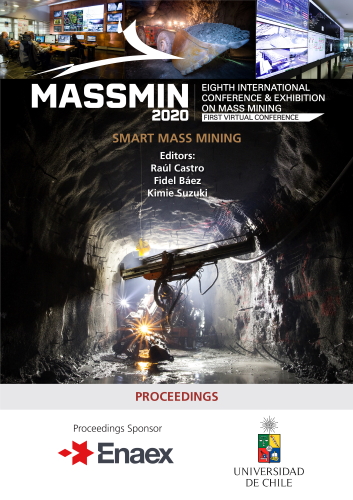Applying artificial intelligence for optimal production scheduling and phase design in open pit mining

|
Authors: Loor, V; Morales, N |
This paper is hosted with the kind permission of Lulea University of Technology, International Conference & Exhibition on Mass Mining, 2024.
DOI https://doi.org/10.36487/ACG_repo/2063_111
Cite As:
Loor, V & Morales, N 2020, 'Applying artificial intelligence for optimal production scheduling and phase design in open pit mining', in R Castro, F Báez & K Suzuki (eds), MassMin 2020: Proceedings of the Eighth International Conference & Exhibition on Mass Mining, University of Chile, Santiago, pp. 1451-1466, https://doi.org/10.36487/ACG_repo/2063_111
Abstract:
The open-pit mine production scheduling (OPPS) problem aims to determine the extraction sequence of mining blocks of an orebody. The OPPS presents several restrictions that create a combinatorial optimization problem classified as NP-hard. Generally, an optimal solution for OPPS cannot be obtained in an acceptable computation time using linear programming; therefore, approximation methods called heuristics have been used to solve it. In this paper, an artificial intelligence (AI) based methodology is proposed to obtain operative pushbacks in open-pit mines respecting operational and design constraints. This integrated approach is achieved through a Genetic Algorithm and a clustering algorithm (k-means). A Genetic Algorithm is a search heuristic inspired by Charles Darwin’s theory of natural evolution and is used to solve NP-hard problems. This methodology has been tested in an iron mine and a gold mine and has been shown to be a practical, viable approach. Results show that pushbacks obtained respect the design and operational constraints of pit extraction, while also maximizing the net present value (NPV).
References:
Alipour, A, Khodaiari, A, Jafari, A & Tavakkoli-Moghaddam, R 2020, ‘Production scheduling of open-pit mines using genetic algorithm: a case study’, International Journal of Management Science and Engineering Management, vol. 15, no. 3, pp. 176-183.
Chandran, B & Hochbaum, D 2009, ‘A computational study of the pseudoflow and push-relabel algorithms for the maximum flow problem’, Oper. Res, vol. 57, no. 2, pp. 358-376.
Chicoisne, R, Espinoza, D, Goycoolea, M, Moreno, E & Rubio, E 2012, ‘A new algorithm for the open-pit mine production scheduling problem’, Oper. Res, vol. 60, no. 3, pp. 517-528.
Espinoza D, Goycoolea M, Moreno E & Newman A 2013, ‘Minelib 2011: A library of open pit production scheduling problems’, Ann. Oper. Res, vol. 206, no. 1, pp. 91-114.
Goldberg, D 1989, ‘Genetic Algorithms in Search, Optimization, and Machine Learning’, Addison-Wesley, Boston, United States.
Holland, J 1975, ‘Adaptation in Natural and Artificial Systems’, University of Michigan Press, Ann Arbor, Republished by the MIT press, 1992.
Jélvez, E, Morales, N & Askari-Nasab, H 2020, ‘A new model for automated pushback selection’, Computers & Operations Research, vol. 115, 2020, 104456.
Jélvez, E, Morales, N, Nancel-Penard, P & Cornillier, F 2020, ‘A new hybrid heuristic algorithm for the Precedence Constrained Production Scheduling Problem: A mining application,’ Omega, vol.94, 2020, 102046.
Johnson, T 1968, ‘Optimum open pit mine production scheduling’, Doctoral dissertation, University of California, Berkeley.
Lerchs, H & Grossmann, I 1965, ‘Optimum design of open-pit mines’, Canadian Mining Metallurgical Bull, vol. 58, no. 633, pp. 47-54.
MacQueen, JB 1967, ‘Some methods for classification and analysis of multivariate observations’, proceedings of the Fifth Symposium on Math, Statistics, and Probability Berkeley, CA: University of California Press, pp. 281-297.
Meagher, C, Dimitrakopoulos, R & Avis, D 2014, ‘Optimized open pit mine design, pushbacks and the gap problem: a review’, Journal of Mining Science, vol. 50, no. 3, pp. 508-526.
Navarro, F 2015, ‘A parallel and distributed genetic algorithm for scheduling blocks in open pit mines’, Master’s thesis, Universidad de Santiago de Chile, Santiago, Chile, in Spanish.
Purnima, B & Arvind, K 2014, ‘A Clustering Technique based on Elbow Method and K-Means in WSN’, International Journal of Computer Applications, vol. 105, no. 9, pp. 0975-8887.
Suárez, M 2017, ‘Design of exploitation phases in open pit mines generated through a genetic algorithm’, Master’s thesis, Universidad de Chile, Santiago, Chile, in Spanish.
Wagstaff, K, Cardie C, Rogers, S & Schroed, S 2001, ‘Constrained K-means Clustering with Background Knowledge’, proceedings of the Eighteenth International Conference on Machine Learning, pp. 577-584.
© Copyright 2025, Australian Centre for Geomechanics (ACG), The University of Western Australia. All rights reserved.
View copyright/legal information
Please direct any queries or error reports to repository-acg@uwa.edu.au
View copyright/legal information
Please direct any queries or error reports to repository-acg@uwa.edu.au
